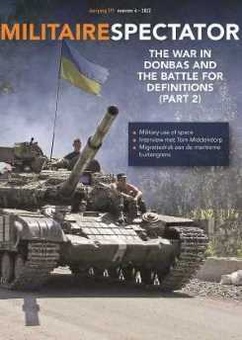The military’s use of space will increase in importance. This article discusses several implications and possible avenues for capability planning in the space domain. How did the use of space develop through major conflicts? And how have conflicts been influenced by the increasing use of space? As with any military domain, when it is being exploited, space will become a target for opponents as well, therefore threats to the use of the space domain are also discussed. Cooperation between states will be essential for a durable use of the space domain.
Future military operations between peer competitors will be characterized by a Multi-Domain Operations (MDO) approach, which feature the integrated and parallel use of air, sea, land, cyberspace and space. Across the spectrum of military operations, from low-tempo peace-keeping missions and security force assistance to high-intensity, high-tempo warfighting operations, the military will make use of all operational domains—but particularly the space domain. Space has become vital to modern military activity as the speed of operations has increased and led to compressed time-cycles for decision-making at the command and control (C2) and tactical levels.[1]

Aurora Borealis as seen from a space station. Whilst space cannot be divided into civilian and military parts, the area of ‘military space’ will feature the traditional powers of the US, Russia and China but also see the addition of new players, such as India. Photo Stuart Rankin
In addition, military activity is more closely scrutinized today given the accelerating and widening access to open-source information in the public domain among civil society actors. One consequence of this has been to intensify the need for more rapid but also more accurate intelligence to inform decision-making in military campaigns. Information from an expanding set of sources and origins has become the ways and means for decision-making and the space domain has figured centrally in this evolution of military planning and operations across the range of missions that militaries are expected to routinely undertake. The space domain is the only way to ensure continuous cross-border intelligence and situational awareness today and facilitate vital communications. This reality necessitates greater attention to be focused on the security of space assets and capability planning for space applications in the future. As it stands, the space domain still does not garner the strategic attention around the world that it already warrants.[2] However, the military’s use of space will not only remain on the agenda of defence organizations and military capability planners for years to come but will increase in importance.
Goal and structure
In the light of the introduction above, this article discusses several implications and possible avenues for capability planning in the space domain. First, a short overview describes how the use of space has developed through major conflicts, and how conflicts have been influenced by the increasing use of space. As with any military domain, when it is being exploited, it will become a target for opponents as well. Threats to the use of the space domain are discussed next, followed by an indication of how the military use of space can be maintained with the right precautions and design principles. Technological solutions aside, cooperation between states will be essential for a durable use of the space domain as well. Conclusions and a warning against too much dependency can be found at the end of this article.
The geopolitics of earth through the use of space
It could be argued that, as far back as World War II, the use of space was already witnessed in warfighting when Germany lobbed V2 rockets with ballistic trajectories towards Britain.[3] In more recent times, the first military campaign in which the space domain played a crucial role took place during the First Gulf War in 1991. Without the use of satellite-enabled GPS that provided precision navigation and targeting for kinetic effects and space-based observation of the conflict theatre for situational awareness the US and its coalition partners may not have achieved the same outcome of Operation Desert Storm that they did.[4] Since the end of the First Gulf War, Western militaries have gradually expanded their use and efforts in leveraging the space domain as a way to introduce operational advantages. However, this growing dependency, or addiction, on the space domain has also created — and enlarged — new types of vulnerabilities for military operations which opponents are increasingly capable of exploiting. In this emerging context it is vital that militaries begin to refocus attention on their use of space in terms of planning and developing space capabilities relative to emerging new threats and strategic vulnerabilities.
This is a challenge that needs to be met at a time when it cannot be denied that great power competition is back on the world stage.[5] As global dynamics have evolved, the United States has been re-balancing its global posture with a pivot to Asia. Falling energy reliance of the US on the Middle East has also triggered discussion around its long-term regional role.[6] For Europe, any future unrest and instability on its eastern and southern borders may lead to unprecedented challenges posed by refugees and displaced persons. In managing the security impact of such risks European militaries could well face a new reality where the reliance on the availability of American space assets cannot be taken for granted.
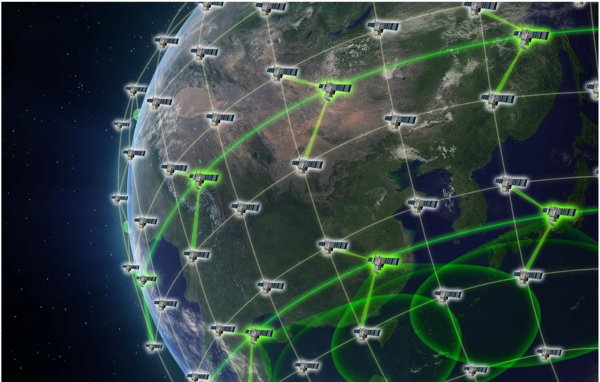
Artist’s concept of a network of satellites. Congestion is a serious threat in space, particularly in Low Earth Orbit (LEO). Photo DARPA
At the same time, Europe’s own resolve to attain strategic autonomy and sovereignty may grow stronger and extend to its future space strategy. Geopolitical factors and increasingly easier and cheaper access to space are likely to continue introducing new players into the frame, pursuing the strategic and tactical use of space, operating satellites and developing ground-based enabling infrastructure.[7] Whilst space cannot be divided into civilian and military parts, the area of ‘military space’ will feature the traditional powers of the US, Russia and China but also see the addition of new players, such as India, the UAE and others like the EU and/or its individual member states.
The widening threat spectrum to the (military) use of space
The risks of using and reliance on space for military operations are increasing rapidly as the number of space actors expands. Congestion is a serious threat in space, particularly in Low Earth Orbit (LEO) — the altitude that spans 400-1,500 kms above the earth — where satellites risk becoming obliterated. LEO is becoming saturated not only by military users but also by a growing range of commercial operators producing and launching high numbers of small satellites to serve the rapidly growing commercial space industry. The US firms SpaceX, managed by Elon Musk, and Jeff Bezos’ Blue Origin (Amazon) have received licenses for establishing satellite constellations in LEO of more than 15,000 satellites in total.[8]
The risks of growing space congestion are real since the widely-studied collision of Iridium-33 and Kosmos 2251 in February 2009,[9] the collision in March 2021 between Yunhai 1-02 and the fragments (also the result of a knock-off) from Russia’s Zenit-2 rocket,[10] which itself was launched in September 1996, emphasized the risks to satellite operations. These recent collisions were most probably accidents. Close proximity manoeuvres on purpose by satellites towards other satellites have been observed recently and such close encounters may be the result of offensive intent designed to render satellites unreliable, untrustworthy or even completely unusable.[11]
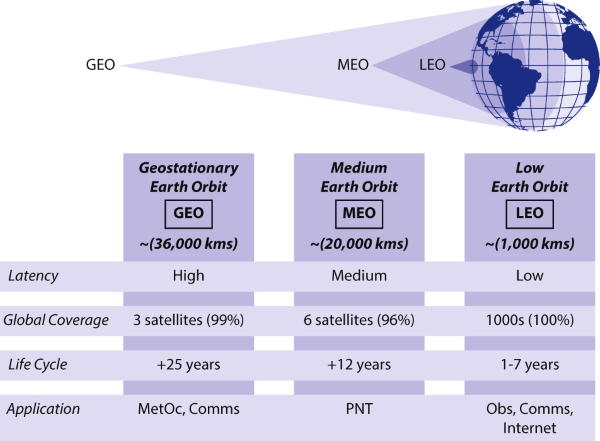
Figure 1 Overview of main constellations of satellites and their application (image created by ViaSat and P.P.M. Bolder)
Recently observed close proximity encounters and operations do not appear to have inflicted any visible damage but these incidents have triggered military actors in space to rethink their postures and consider mechanisms for enhancing the protection of their assets — including, potentially, through weaponization. In 2019 France announced that it would weaponize its space assets and set up a Space Force[12] and in December, NATO explicitly acknowledged space as a military operations domain.[13] Anti-satellite (ASAT) weapons are known to have been experimented with widely and are likely to be developed more readily as a way to introduce the logic of deterrence and denial into the space domain against opponents that may seek to exploit legacy space system vulnerabilities.[14] The latest demonstration of this kind took place only recently, on November 15. A Russian Nudol rocket obliterated a long-time defunct Russian Cosmos 1408 satellite, adding at least 1,500 pieces of debris to the 30,000 (at least) already littering space.[15]
There are major implications for such trajectories because of the unintended consequences and secondary effects such developments would generate at the lowest level, simply through the risk of debris spreading across significant swathes of space. Opponents in space will also seek to target the critical communications relays between satellites and supporting ground infrastructure or command centres. Technologically less advanced opponents could attack or disrupt ground-based infrastructure supporting space operations by simply denying physical access, cutting power cables or even launching physical attacks and destruction.
The widening spectrum of threats in space is not all-encompassing. For the time being, these threats mainly relate to space assets in LEO, where there are a series of defensive responses – available to military planners who focus on the LEO environment — for example, the hardening of supporting and enabling terrestrial infrastructure, earth-to-space (and vice versa) communication channels and also space-based assets themselves. Additionally, military planners will need to generate new ways and means for improved space situational awareness, space traffic management, manoeuvrability in space, responsiveness and payload adaptability as well as, crucially, international cooperation and efforts towards creating a rules-based order in space. But higher orbiting satellites in Medium Earth Orbit (MEO) have also been threatened recently. In these orbits the Navigation, Positioning and Timing (PNT) signal delivering constellations circle the earth. Chinese Beidu constallation, Russian Glonass and US GPS perform their essential functions around 20,000 kms above the earth’s surface. On November 29 a Russian Channel One TV host allegedly threatened to destroy US GPS satellites when NATO would cross Russian ‘red lines’.[16]
Terrestrial communications and satellite hardening
The easiest ways for opponents to target space capabilities supporting military operations is to focus on the terrestrially-based supporting and enabling infrastructure. Fortunately, these elements of space capability are the easiest to defend and, if necessary, repair or replace. Whilst this may initially seem a less sophisticated and low-cost response to reducing vulnerabilities for military space operations, it is vital not to allow this element of future space power and capability planning to escape the strategic design and planning process.
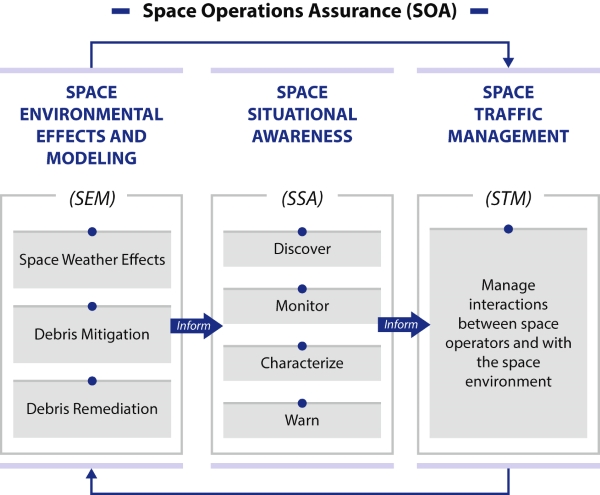
Figure 2 Several functionalities, particular uses and dependencies of the use of space (image by 10th DIACC, November 2021)
As cyberspace meets space, a dual vulnerability is introduced, particularly for military communications. The C2 and information channels between ground and space-based assets are highly sensitive to spoofing, disturbance, jamming and other forms of interference.[17] Securing data and information flows through optical communication,[18] cryptology, frequency hopping or pinpointed radio transmission will need a capability design parameter as a vital feature.
Satellites themselves are also increasingly likely to become the subject of offensive manoeuvres and actions to render them less effective or even useless.[19] Military actors in space must begin to consider and address how space-based assets can be protected against physical attacks, exposure to high energy radiation, electromagnetic tampering and a range of emerging new threats from earth. Special coatings and layers, sensors that detect tampering and the enhancement of defensive and appropriate countermeasures will need to be developed and implemented.
Space Situational Awareness (SSA), space traffic management and manoeuvrability
SSA underpins an accurate real-time picture of the space domain and makes insights into unexpected or unusual occurrences possible.[20] With SSA, satellite operators can better monitor and control the proximity of their assets to potential threats and collision risks — particularly as it applies to evading space debris in LEO. The necessary configuration of sensors and data processing technologies will be able to provide early warning against the possible intrusion of satellite safe bubbles as well as identifying harming actions by other objects, possibly operated by hostile actors. In the emerging scenario, deniability of offensive manoeuvres and actions will be out of the question and perpetration can be seen and identified. Logically, attribution of unwanted actions facilitates a more robust model of deterrence which can be enforced.
Improved SSA provides a more accurate picture of space and facilitates calculations concerning proximity of assets in space. This will assist in developing a space traffic management system to prevent collisions. Improved SSA will lead to the reduction of a satellite’s safe bubble as it is constituted and in turn this will reduce the propensity for evasive manoeuvring while offering safer ways to achieve and maintain safe navigation and mobility in space. By also enabling space traffic management, the security of space-based systems will be enhanced, prolonging satellite lifespans and support better planning for replacements, upgrades and new insertions.
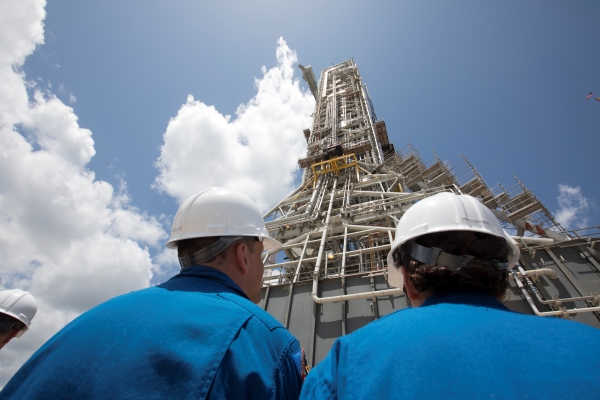
Close-up view of a mobile launcher at NASA’s Kennedy Space Center in Florida. The military use of space should take the protection of ground-based infrastructure into account. Photo NASA
Enhancing the manoeuvrability of satellites is an imperative defensive measure to enhance their protection and survivability. Manoeuvrability in space for security is analogous to that of regular military ground-units. Mobility will enhance the protection but in space a more complex set of challenges will need to be addressed, such as fueling, on station-time and tactics, techniques and procedures (TTPs).
Design, responsiveness and payload adaptability
In the event of losing satellites as a result of offensive actions by an opponent, natural circumstances or even an accident, it will be critical to replace any lost capability in the shortest time possible—with a like-for-like or improved system. Indeed, the future of satellites lies with micro or nano-satellites which are less costly and time-consuming to build and launch in comparison to legacy space systems.[21] Where the need for new functionalities and requirements emerges, new space technologies will create new ways to deliver these in more responsive ways. Responsiveness in design, manufacture, testing, procedures and launch will need to be key criteria, for space military capability planning ought to be supported by close and continuous cooperation with industry and knowledge partners.
In the design of new satellites and space systems, the development of new applications may need to be spread out over more partners in order to build and launch satellites more rapidly and cost-effectively. Implementing new and constantly evolving requirements through development programmes is unreasonable and militaries must become better at pushing these towards future iterations. Constant change and modifications to space development programmes may cause huge cost and time delays. Instead, the focus must be on making satellites more modular or adaptable so that their functionality can be modified (even from earth!) without great cost and with less complexity. If high modularity and adaptability is built into the current generation of satellites under development, their usability and lifespans would be enhanced enormously.
International cooperation and a rules-based order in space
For smaller military organisations and particularly those that cooperate under a common security umbrella, burden-sharing through a division of responsibilities and capabilities is strategically compelling. The pooling and shared use of assets and capabilities will be a crucial feature of developing space capabilities that will rest on successful outcomes in international cooperation. International cooperation regarding the use of space will also need to address the extensive freedom that currently exists for any actor in space in the absence of rules on behaviour. Until now the limited number of nations with advanced space capabilities have apparently been reluctant in creating more specific frameworks and in developing long-term rules among themselves to avoid hampering the future range of strategic possibilities.[22] Yet with increasing congestion in LEO, the emergence of new (military) actors in space and its evolution as a contested operational domain, space should no longer be accessed and exploited in the absence of a minimum set of rules and acceptable risks.
Conclusion
The widening spectrum of threats — increasingly cross-domain in nature — and the acceleration in military decision-making required given massive increases in data produced or becoming available, exacerbates future challenges for warfighters. Hybrid warfare and military competition below the threshold of open conflict will need systems that support the military planners and operators with early warning, superior situational awareness and prompt decision-making. Rapid access to information while integrity is guaranteed will be crucial to strategic success. Along with all these strategic imperatives, the space domain will have a vital role to play.
Where dependency on the space domain for future military operations is obvious, continued access to assets in space is required even when these assets have become targets themselves. This article reflected upon ways and means to assure the future use of military space through proper capability planning.
Access to the space domain comes with enough challenges on its own but in the context of the military use of space, even more must be considered. Aside from all the perceived problems and challenges the increased dependency on space and growing use of the space domain is inescapable. The new strategic and operational advantages will require technical solutions and enhanced international cooperation to foster the unobtrusive use of space. Ultimately, though, it should not be lost on militaries to think about how the loss of access to critical space infrastructure will be negotiated. At a time when access to space is taken for granted, the military skills of map and compass reading, field orientation, navigation and operating without communications may need to be preserved.
[1] Bleddyn E. Bowen, War in Space: Strategy, Spacepower, Geopolitics (Edinburgh, Edinburgh University Press, 2020) 19-21.
[2] Albert K. Lai, The Cold War, the Space Race, and the Law of Outer Space: Space for Peace (Londen en New York, Routledge, 2021).
[3] Suzanne Deffree, ‘German Rocket Is 1st to Reach Space, October 3, 1942’, EDN, 3 October 2019. See: https://www.edn.com/german-rocket-is-1st-to-reach-space-october-3-1942/.
[4] Charles Pope, ‘30 Years Later, Desert Storm Remains a Powerful Influence on Air, Space Forces’, U.S. Air Force. See: https://www.af.mil/News/Article-Display/Article/2512938/30-years-later-desert-storm-remains-a-powerful-influence-on-air-space-forces/.
[5] Center for Strategic and International Studies, ‘Great Power Competition’. See: https://www.csis.org/analysis/great-power-competition.
[6] Sheela Tobben and Julia Lee, U.S. imports no Saudi crude for first time in 35 years’, Bloomberg, 6 January 2021. See: https://www.bloomberg.com/news/articles/2021-01-06/saudi-oil-exports-to-u-s-at-zero-for-first-time-in-35-years.
[7] The Hague Centre for Strategic Studies, Strategic Alert: Towards a Space Security Strategy, 31 March 2021. See: https://hcss.nl/report/strategic-alert-towards-a-space-security-strategy/.
[8] David Shepardson, ‘U.S. FCC Approves SpaceX Satellite Deployment Plan’, Reuters, 27 April 2021. See: https://www.reuters.com/technology/fcc-votes-approve-spacex-satellite-plan-official-2021-04-27/.
[9] Linda Dawson, War in Space: The Science and Technology Behind Our Next Theater of Conflict (Cham, Springer, 2019) 50.
[10] Isabella Richards, ‘Debris from 1996 Russian Rocket behind Yunhai 1-02 Breakdown’, Space Connect Online, 18 August 2021. See: https://www.spaceconnectonline.com.au/launch/5027-russian-rocket-potentially-caused-the-yunhai-1-02-breakdown-in-march.
[11] Loren Grush, ‘Russia Just Tested Satellite-Destroying Tech in Space, US Space Command Claims’, The Verge, 23 July 2020. See: https://www.theverge.com/2020/7/23/21335506/russia-anti-satellite-weapon-test-kosmos-2543.
[12] Hanneke Weitering, ‘France Is Launching a “Space Force” with Weaponized Satellites’, Space, 2 August 2019. See: https://www.space.com/france-military-space-force.html.
[13] NATO, ‘Foreign Ministers Take Decisions to Adapt NATO, Recognize Space as an Operational Domain’, 20 November 2019. See: https://www.nato.int/cps/en/natohq/news_171028.htm.
[14] Secure World, ‘SWF Releases Updated Compilation of Anti-Satellite Testing in Space’, 30 June 2020. See: https://swfound.org/news/all-news/2020/06/swf-releases-updated-compilation-of-anti-satellite-testing-in-space/.
[15] Ankit Panda, ‘The Dangerous Fallout of Russia’s Anti-Satellite Missile Test’, Carnegie Endowment for International Peace, 17 November 2021. See: https://carnegieendowment.org/2021/11/17/dangerous-fallout-of-russia-s-anti-satellite-missile-test-pub-85804.
[16] Tracy Cozzens, ‘Russia Issues Threat to GPS Satellites’, GPS World, 29 November 2021. See: https://www.gpsworld.com/russia-issues-threat-to-gps-satellites/.
[17] Sarah Mountin, ‘The Legality and Implications of Intentional Interference with Commercial Communication Satellite Signals’, U.S. Naval War College, 2014. See: https://digital-commons.usnwc.edu/cgi/viewcontent.cgi?article=1013&context=ils.
[18] ESA, ‘Laser Communications’. See: https://www.esa.int/Applications/Telecommunications_Integrated_Applications/EDRS/Laser_communications.
[19] Niall Firth, ‘How to Fight a War in Space (and Get Away with It)’, MIT Technology Review, 26 June 2019. See: https://www.technologyreview.com/2019/06/26/725/satellite-space-wars/.
[20] Secure World Foundation, ‘Seeing space security: the role of space situational awareness for verification of future space arms control’, 10 November 2020. See: https://swfound.org/events/2020/seeing-space-security-the-role-of-space-situational-awareness-for-verification-of-future-space-arms-control.
[21] Margaret Davis, ‘Nanosatellites Are the Future of Satellites: Earth Observation Now Smaller, Cheaper Than Ever’, Science Times, 13 October 2021. See: https://www.sciencetimes.com/articles/33939/20211013/nanosatellites-future-satellites-earth-observation-now-smaller-cheaper.htm.
[22] Donald R. Rothwell, ‘Bringing Space Law into the 21st Century’, The Interpreter, 15 December 2020. See: https://www.lowyinstitute.org/the-interpreter/bringing-space-law-into-21st-century.
